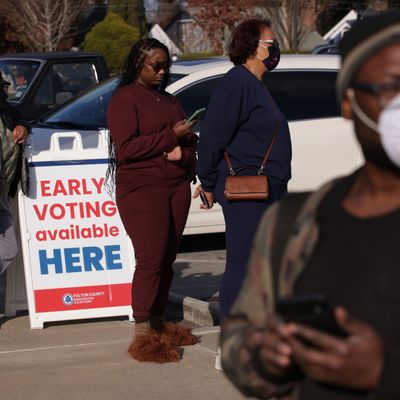
As analysts pick over the results of the 2022 midterm elections, there have been a lot of mixed messages for Democrats. Yes, they performed better than you might have expected for the party controlling the White House, especially considering the president has underwater job-approval ratings. And yes, Democrats benefited from an unusually robust performance among young voters, who often don’t participate in midterm elections. But at the same time, Democrats didn’t significantly improve their performance among other key demographics, notably Black, Asian American, and Latino voters. As my colleague Eric Levitz observed, Democrats remain dangerously dependent on white college-educated voters who remain sympathetic to Republican economic messages.
Worse yet for Democrats, there is growing evidence that their single most loyal demographic group, African Americans, was underenthused in 2022. The New York Times’ Nate Cohn looked at the preliminary numbers and sounded the alarm:
Georgia and North Carolina are two of the states where voters indicate their race when they register to vote, offering an unusually clear look at the racial composition of the electorate. In both states — along with Louisiana — the Black share of the electorate fell to its lowest levels since 2006.
In all three states, the turnout rate among Black voters was far lower than among white voters. In North Carolina, for example, 43 percent of Black registered voters turned out, compared with 59 percent of white registered voters — roughly doubling the difference from 2018 and tripling the racial turnout gap from 2014.
While similarly conclusive data is not available elsewhere so far, the turnout by county suggests that a relatively weak Black turnout was a national phenomenon.
Low Black turnout in Georgia and North Carolina is especially significant because Black candidates (Senate candidate Cheri Beasley in North Carolina and Senate Democratic candidate Raphael Warnock and gubernatorial candidate Stacey Abrams in Georgia) headed up the Democratic tickets in both states. It’s not like the old days when Black voters were being urged to support white conservative Democrats to thwart even more conservative Republicans.
If the signs of relatively low Black turnout in 2022 are accurate and representative, what do they mean? Cohn offers some possible explanations:
Still, relatively low Black turnout is becoming an unmistakable trend in the post-Obama era, raising important — if yet unanswered — questions about how Democrats can revitalize the enthusiasm of their strongest group of supporters.
Is it simply a return to the pre-Obama norm? Is it yet another symptom of eroding Democratic strength among working-class voters of all races and ethnicities? Or is it a byproduct of something more specific to Black voters, like the rise of a more progressive, activist — and pessimistic — Black left that doubts whether the Democratic Party can combat white supremacy?
It’s possible to overinterpret Black voter trends. According to exit polls, the Democratic share of Black voters dropped from 90 percent in 2018 to 87 percent in 2020 and 86 percent in 2022 — not exactly a deep plunge. And some of the negative turnout trends may be attributable to voter-suppression efforts in Republican-controlled states rather than Black voter disaffection with Democrats.
But any way you cut it, Democrats have both a practical and a moral responsibility to boost Black voter participation in elections going forward. In particular, President Joe Biden, whose nomination and election in 2020 depended heavily on Black support, should devote a lot of attention to rekindling the fires of affection in this critical segment of the electorate.






























